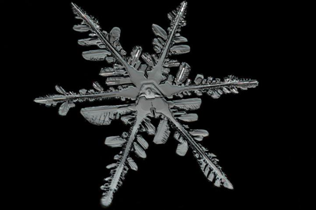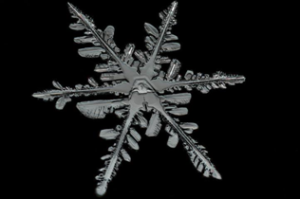什么是晶体?
https://zh.wikipedia.org/wiki/%E6%99%B6%E4%BD%93
Dear Dr. Universe: What are crystals? Who discovered them? -Kennedy, 9, Little Rock, AK

编译 七君
Dear Kennedy,
Maybe you’ve caught a snowflake on your tongue. Or sprinkled salt on your food. Perhaps you’ve imagined what it would be like to explore a big crystal cave.
你见过下雪吗?你曾经用手捧过雪花吗?雪花是冰做的,用显微镜看的话,你可以发现雪花的形状很有规律。做饭时用到的盐粒和砂糖,都是形状相似的小颗粒。它们和雪花都有关系,因为它们都是晶体。
Crystals come in all shapes, sizes, and colors. A lot of them are born from hot magma, deep in the Earth that cools slowly. If you look at a rock, you might even be able to spot some of these crystals.
晶体的形状、大小和颜色各不相同。在地球深处的岩浆里就会产生许多晶体。不信你可以看一看岩石,这些来自岩浆的石头里就蕴含着许多晶体。
We can find crystals in nature, but engineers and scientists can also make them in labs. My friend Kelvin Lynn, a materials engineer, is really curious about crystals. He makes them in his lab here at Washington State University.
大自然里有许多晶体,比如石英、金刚石、冰、干冰、铁、铜、铝都是晶体,不过它们中的一些是分子晶体,一些是原子晶体,一些是金属晶体。我们在实验室和工厂里也可以制造晶体。
Lynn explained that crystals are made up of atoms. The atoms are arranged in very particular ways. In order to be a crystal, these atoms have to form a pattern. When scientists see this pattern happening throughout a solid, they call it a crystal lattice.
晶体是由原子构成的,原子以特定的方式排列,比如对称排列,那么就能形成晶体。如果科学家发现某种固体中原子的排列有某种规律——或者说周期性,也就是能够不断重复自己的话,那么这种固体就是晶体,原子形成的规则的小格子就被叫做晶格。
The opposite of a crystal is what scientists call an amorphous solid. The glass in our windows is one example. It has atoms that are not arranged in a pattern. They are much more scattered than the atoms of a crystal.
如果某个固体里的原子排列没有什么规律,那么这种固体就叫非晶物质,或者说无定形体。玻璃就是一种无定形体,玻璃中的原子排列乱糟糟的,并没有什么规律,没有形成一格一格的小房子——晶格。实际上,玻璃内部的分子排列就像液体那样没什么规律。
Understanding a material’s structure can help scientists learn more how a material behaves, Lynn explained. If it will conduct electricity or heat, for example. In Lynn’s lab, they are curious about how crystals can be used to create power from sunlight.
如果我们理解某种固体材料的结构,,那么我们就能够更好地理解这种材料的性质,比如它能不能导电、导热,并且更好地利用它。
As for the second part of your question, the idea of crystals and their structures has been around for hundreds of years, Lynn adds. But it wasn’t until about the early 1900s that scientists could get a closer look with X-rays. Sir William Henry Bragg and his son were the first to use this technology to look at the structures of common crystals, including table salt.
其实,晶体这个概念并不是最近才被提出的,几百年前人们就意识到一些固体有着特殊的规律结构。因为一些固体碎了以后,碎末的形状也总是很有规律,它们实际上就是晶体。你看砂糖的样子不都是很规整的吗?
不过,直到20世纪早期,科学家们才用X光对晶体进行了近距离观察。英国物理学家威廉·亨利·布拉格和他的儿子是首先用X光技术观察晶体结构的人,他们曾经观察过盐等常见的晶体。
I decided to do a little crystal investigation of my own. After whipping up some eggs for breakfast, I had an idea.
I cleaned out the eggshell halves and covered their insides with glue. I sprinkled them with a bit of white powder called alum from the spice section at the store.
你在家里也可以观察晶体哦。你可以把蛋壳一分为二,你还需要一些明矾、水和色素。
I tapped off the extra alum and let the shell sit overnight. The next day, I added some food coloring, about a cup of alum, and two cups of boiling water to a big jar.
那要怎么做呢?先在蛋壳里面涂一些胶水,然后撒上一些明矾,放一个晚上。第二天,你要在一个大罐子里倒上两杯滚水,大约等于两袋牛奶的量,接着加入一杯明矾,最后添一些色素。
Once the water cooled, I pushed the eggshells to the bottom of the liquid. As they sat, alum powder particles falling on the eggshells started attaching to each other.
当水冷却以后,把粘着明矾的蛋壳丢进去。接着你就可以看到蛋壳上慢慢长出晶体的绚丽过程了。
They began to crystalize. Before long, they looked less like eggshells and more like the sparkling insides of a geode. You can try some science of your own and investigate crystals, too. Just watch the video below to get all the instructions. Tell me about your project sometime or send us a picture at Dr.Universe@wsu.edu.
最后,你就会得到一个漂亮的晶洞啦,它就像水晶矿一样闪闪发光














留言